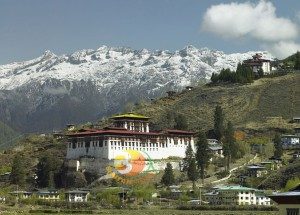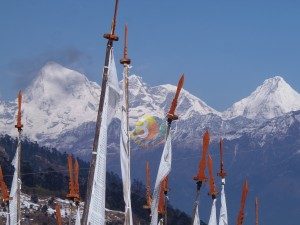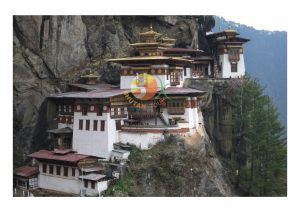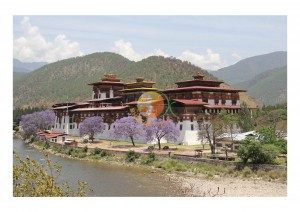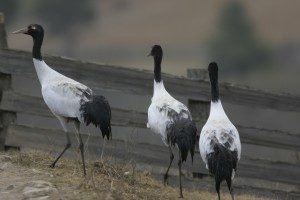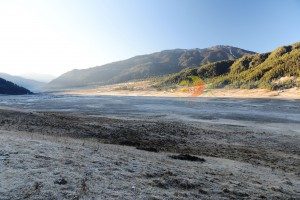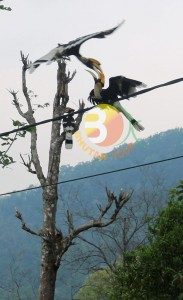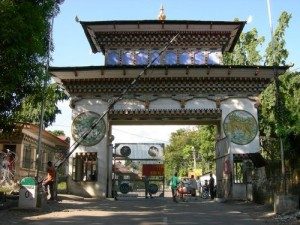Bhutan is a paradise for bird lovers and ornithologists. Over 670 species of birds have been recorded and much more are yet to be discovered. Around 50 species of the known birds are winter migrants. These include ducks, waders, birds of prey, thrushes, finches, and buntings.
The partial migrants to Bhutan include cuckoos, swifts, bee-eaters, warblers, and flycatchers. The country harbors more than 16 species of vulnerable birds. They are the Pallas’s Fish Eagle, White-bellied Heron, Satyr Tragopan, Gray-bellied Tragopan, Ward’s Trogon, Blyth’s King Fisher, Yellow-rumped Honey Guide, Rufous Throated Wren Babbler, Chestnut-breasted Partridge, Blyth’s Trogon, Wood Snipe, Dark-rumped Swift, Rufous-necked Hornbill, Gray-crowned Prinia and the Beautiful Nuthatch all of which breed in Bhutan.
Day 1: Arrive Paro – Birding along Paro River
Day 2: Paro – Chelila Birding
Day 3: Paro – Tiger’s Nest Excursion – Thimphu
Day 4: Thimphu – Dochula – Punakha
Day 5: Birding Inside Jigme Dorji National Park
Day 6: Punakha – Nobding – Phobjekha
Day 7: Phobjekha – Pelela – Trongsa
Day 8: Trongsa – Zhemgang
Day 9: Zhemgang – Tingtibe – Gomphu Road
Day 10: Zhemgang – Yotongla – Bumthang
Day 11: Bumthang – Thrumshingla – Sengor
Day 12: Sengor – Namling – Yongkala
Day 13: Yongkala – Namling – Limithang Road
Day 14: Yongkala – Namling – Limithang Road
Day 15: Yongkala – Korila – Trashigang
Day 16: Paro – Trashigang – Khaling – Morong
Day 17: Morong – Dewathang – Samdrup Jongkhar
Day 18: Samdrup Jongkhar – Guwahati
Day 1. Arrive Paro – Birding along Paro River
The flight into the Himalayas is one of the most scenic and breathtaking ones with the views of some of the tallest mountains in the world. On your arrival at the Paro international airport, you’ll be received by our representative at the Paro International airport. Transfer to the hotel.
Afternoon visits the Paro Rimpung Dzong (fortress). In the evening birding along the Paro River searching for one of the biggest target birds, Ibisbill, other species we’ll be looking for are Plumbeous Redstarts, Oriental Turtle Dove, Rock Pigeon, River Lapwing, Olive-backed Pipit, Red-billed Chough, Common Hoopoe, Black-tailed Crake, Grey-backed Shrike, Blue Whistling Thrush, White-collared Blackbird, Black Bulbul, White Wagtail, Eurasian Tree and Russet Sparrow.
Overnight: Paro.
Day 2. Paro – Chelila Birding
Very early in the morning drive to the cool alpine meadow of Chelila pass (3890m). This is the highest pass on the car road. Here we should be reward with the three different species of Pheasants, Colorful Himalayan Monals, Blood Pheasants and Kalij Pheasants. Beside this you’ll also see other birds like Rufous-bellied and Darjeeling Woodpecker, Large Hawk and Eurasian Cuckoo, Black Eagle, Eurasian Jay, Yellow-billed Blue Magpie, Spotted Nutcracker, Long-tailed Minivet, Chestnut-bellied Rock Thrush, Rufous-gorgetted and Ultramarine Flycatcher, Indian Blue Robin, White-browed Bush Robin, Orange-flanked Bush Robin, Blue-fronted Redstart, Hodgson’s Treecreeper, Rufous-vented, Coal, Green-backed and Grey-crested Tits, Buff-barred Warbler, Tickell’s Leaf, Blyth’s Leaf and Large-billed leaf Warblers, White-throated, Black-faced, Chestnut-crowned and Spotted Laughingthrushes, Dark-rumped and White-browed Rosefinches.Evening: Free time to stroll around Paro town
Overnight: Paro.
Day 3. Paro – Tiger’s Nest Excursion – Thimphu
After breakfast at the hotel, 15 minutes drive from here will take you to the parking lot at the base of the Tiger’s Nest monastery, from here you can hike to one of the most beautiful and holiest temples in Bhutan. As Bhutan’s most scenic icon and most important destination for pilgrimages and reflection for over 1200 years, Takshang (or the “Tiger’s Nest”) clings to the side of a steep cliff some 200 meters above the Paro valley.
The place was first visited by Guru Rimpoche, founder of the tantric form of Buddhism in Himalayan countries, in the 8th century. It was said that he meditated there for about three months. After him, many high Buddhist priests came to meditate at this location and attained the highest level of spirituality. The original temple was built in the 17th century, but tragically, it was consumed by fire in 1998. Like a phoenix, the temple was rebuilt to its fullest glory in 2003. Takshang is considered to be the 10th-holiest site in the Buddhist world.
The total hike will take the average person about four hours. From the parking area, it will take about one hour to the tea house (rest and refreshment provided) and then another one and a half hours to the temple. Then in the evening drive to Thimphu, the capital city of Bhutan. The drive will take about an hour and a half.
Overnight: Thimphu.
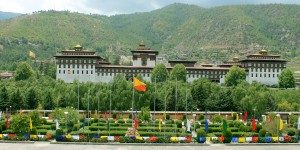
Day 4. Thimphu – Dochula – Punakha
Early morning drive to Punakha over the Dochula Pass (3150). Our day starts from this pass with the breathtaking views of eastern Himalayas ranges. The mixed forests of hemlock, fir, oaks, and rhododendron here are good habitat for many good species including, Fire-tailed Myzornis, White-throated, Spotted and Striated Laughingthrushes, Oriental, Indian, and Large Hawk Cuckoos and Rufous-gorgeted Flycatcher.
After breakfast at the pass, we descend down to the Lamperi Botanical Garden and take the nature walk for about hours, birds we’ll be looking here include Brown Parrotbill, Barred Cuckoo Dove, Wedge-tailed Green Pigeon, Maroon Oriole, Streak-breasted Scimitar Babbler, Scarlet Finch, Spot-winged Grosbeak, Eurasian Jay, Grey-winged Blackbird and b-footed Bush Warbler.
Afternoon: Visit Punakha Dzong we’ll visit impressive Punakha Dzong suppose to be one of the most beautiful dzong in Bhutan. After finish visiting the Dzong drive along the Po-chu River looking for White-bellied Heron, Pallas’s Fish Eagle and other shores birds.
Overnight: Punakha.
Day 5: Birding Inside Jigme Dorji National Park
You will spend the whole day birding inside the Jigme Dorji National park and along Mo chu River. We have the possibilities of seeing Red-headed Trogon, Wallcreeper, Slaty-bellied Tesia, Small and Large Niltava, Black-chinned Yuhinas, a trio of forktails, Pygmy and Spotted Wren-babblers, Woodpeckers, Laughingthrushes, and with luck White-bellied Heron and Pallas’s Fish Eagle.
We also have a good chance of finding the species like Oriental Turtle Dove, Great Cormorant, Blue Whistling Thrush, Plumbeous Water Redstart, Rufous Sibia, Grey-headed Canary Flycatcher,Green-backed Tit, Brown Dipper, White-capped Water Redstart, White-throated Laughingthrush, Golden-throated Barbet, Great Barbet, Crested Kingfisher, Grey Treepie, Ashy Drongo, Verditer Flycatcher, Brown-throated Treecreeper, Black-throated Tit, Black Bulbul, Red-vented Bulbul, River Lapwing, Grey Wagtail, Gadwall, and Large-billed Crow
Overnight: Punakha.
Day 6. Punakha – Nobding – Phobjekha
Early morning you’ll wind up your way to the Phobjekha valley (4hrs) stopping along the way looking for Brown Dipper, Ward’s Trogon, Yellow-rumped Honeyguide, Cutia, Grey-bellied Tesia, Grey-hooded, Blyth’s and Black-faced Warblers, Green-tailed and Mrs. Gloud’s Sunbird, Striated Prinia, Blue-capped and Chestnut-bellied Rock Thrush, Pale-Blue Flycatcher, White-capped River Chat, White-tailed Nuthatch, Rusty-flanked Treecreeper, Yellow-browed Tits and few different species of Cuckoos.
Before reaching Pelela pass we’ll take the road to Phobjekha valley, crossing Lawala pass the vegetation changes into dwarf bamboo, here you’ll searching for the species like Spotted, Chestnut-crowned and Black-faced Laughingthrushes, Spotted Nutcracker, Great and Brown Parrotbills, Oriental Skylark, White-browed Shortwing Yellow-billed Blue Magpie, Chestnut-headed Tesia, Red-billed Chough, Large-billed and Whistler’s Warbler, Slender-billed Scimitar Babbler and Oriental Skylark.
Overnight: Phobjekha (3000m).
Day 7. Phobjekha – Pelela – Trongsa
After early breakfast, we’ll drive to the Pelela pass (4000) and spend the morning hours birding along the old road at Pelela for high altitude species like Spotted Laughingthrush, Himalayan Griffon, Great and Brown Parrotbill, Plain Mountain Finch, White-winged and collared Grosbeak, Spotted Nutcracker, Slaty-blue, Verdier and Dark-sided Flycatcher, Grey-sided Bush Warbler and varieties of Tits, Some of the key birds you’ll be looking her include Himalayan Monal, Dark-rumped Rosefinch, Scarlet Finch and Gold-naped Finch
Along the drive to Trongsa along the drive, we’ll also be looking for the species like Speckled Wood Pigeon, Ultramarine Flycatcher, Golden-breasted and White-browed and Rufous-winged Fulvetta, Streak-breasted and Rusty-cheeked Scimitar Babbler. Black-winged Cuckoo Shrike, Yellow-rumped Honeyguide, Nepal House Martin, Blyth’s Swift and White-throated Needletail, Black Eagle and many more.
Overnight: Trongsa
Day 8. Trongsa – Zhemgang
Today on our drive to Zhemgang, we will have lots of stops at several-forested valleys, the species you’ll for looking for along the drive are Rusty-cheeked Scimitar Babbler, White-browed Scimitar Babbler, Streak-breasted Scimitar Babbler, Grey-bellied Tesia, Crested Bunting, Spot-winged Starling, Long-tailed Shrike, Black-throated and Hill Prinia, Rufous Woodpecker, Sultan Tit, Yellow-cheeked Tit, Common Green Magpie, Rufous-bellied Eagle, Mountain Hawk Eagle, Common Kestrel, Blue-capped Rock-thrush and various minivets. Just to name the few. This is also our best chance for the Golden Langur, a rare monkey endemic to Bhutan and only discovered in the 1950s.
Later in the evening, we’ll be birding Zhemgang – Dakphel road searching for the species like Blyth’s Shrike Babbler, Cutia, Yellow-rumped Honeyguide, Black-eared Shrike-Babbler, Hornbill, Red-faced Liocichla, Rufous-chinned Laughingthrush and may more…
Overnight: Tingtibe Camp (800m)
Day 9: Zhemgang – Tingtibe – Gomphu Road
Today you’ll explore wide varieties of habitats on the Zhemgang – Tingtibe roads. Habitats vary from mossy forests to streamside lowland forest. This is another chance to see Golden Langur, which is fairly common here. We’ll also be searching for Rufous-necked and Great hornbill, Pin-tailed and Wedge-tailed Green Pigeon, Cutia, Scarlet Minivet, varieties of beautiful Laughingthrushes, Spotted Wren Babblers and very rare and sought after Beautiful Nuthatch.
In the afternoon we’ll be exploring the Gomphu Road, the road that goes to Manas National Park, here we’ll be searching for the species like Lesser Rufous-headed Parrotbill, White-hooded Babbler, Grey-throated and Rufous-capped Babbler, Lesser Yellownape, Blue-bearded Bee-eater, Lesser Necklaced Laughingthrush, Blue-throated Flycatcher, Striated and Black-chinned Yuhinas, Chestnut-winged and Drongo Cuckoo, Common Green Magpie, Emerald Dove and with the little bit of luck Pale-headed Woodpecker.
Overnight: Tingtibe Campsite (800m).
Day 10. Zhemgang – Yotongla – Bumthang
After your final morning birding, we will work our way back to Trongsa, looking along the way for the species we might have missed before.
After Trongsa it is another 3hrs drive take you through the Yotongla pass. Here we will search for Hill Partridge, Chestnut-tailed Minla, Brown and Great Parrotbill, Chestnut-crown, Black-faced and Spotted Laughingthrush, Darjeeling Woodpecker, Red-headed Bullfinch, Slender-billed Scimitar Babbler, Scaly-breasted Wren Babbler, Grey-crested, Coal, Rufous-vented and Rufous-fronted Tits, Rufous-breasted Accentor, Plain Mountain Finch, Chestnut-headed Tesia, Rufous-gorgeted and Slaty Blue Flycatchers,
After crossing Yotongla will bring you to the Chumey valley in Bumthang. Bumthang is famous for its distinctive woolen weaves, known as yathra. At the village of Zugney you will see the fine samples of yathra hanging by the roadside. The weavers all women can be seen at their looms beside the road. The road continues over the Kikila pass to enter the next valley in Bumthang (Jakar) the district headquarters,
Overnight: Bumthang
Day 11: Bumthang – Thrumshingla – Sengor
We drive from Bumthang to Sengor going over Thrumshingla (3800m). Thrumshingla is the prime habitat for Blood Pheasants and also hold other high altitude species like, Snow Pigeons, Orange-flanked Bush Robin, Golden and White-browed Bush Robin, Fire-tailed Myzornis, Spotted Nutcracker, Red-billed Chough, Fire-tailed Sunbirds, Greats Parrotbills, Stripe-throated and Rufous-vented Yuhinas, Grey-crested, coals, Rufous-vented Tits, White-browed Fulvata, Dark-rumped Rosefinch, Plain-backed Thrush, White-collared and Grey-winged Blackbird, Rusty-flanked Treecreeper Buff-barred, Ashy-throated, Blyth’s and Large-billed Leaf Warbler.
Later in the evening, we will be birding around Sengor looking for Satyr Tragopan. Sengor is known as the hotspot for Satyr Tragopan. Other birds you’ll be looking out here include Bar-winged and Scaly-breasted Wren Babbler, Gold-naped Finch, Hoary-throated Barwing, Bar-throated and Red-tailed Minlas, Whistler’s and Grey-hooded Warbler and Slender-billed Scimitar Babbler. In the evening you’ll also try for the Himalayan Owl, which comes around your campsite.
Overnight: Sengor Camp (3000m).
Day 12: Sengor – Namling – Yongkala
Before breakfast, we’ll once again drive toward Thrumshinla pass to try for the Blood Pheasant and Satyr Tragopan.
Then we will hit Bhutan’s wet subtropical forest and one of the finest birding areas in the Himalayas. For the next two days you will be birding the lush forested valley searching for Black-headed Shrike Babblers, Ward’s Trogon, Slender-billed, Streak-breasted Scimitar Babblers, Yellow-rumped Honeyguide, Golden-throated and Great Barbet, Coral-billed and Slender-billed Scimitar Babblers, Black-throated and White-breasted Parrotbills, Golden-breasted, Yellow-throated, Rufus-winged and Nepal Fulvettas, Grey Treepie, Green-tailed, Black-throated and Crimson Sunbirds, Fire-breasted Flowerpecker, Streaked Spiderhunter, Grey-sided and Blue-winged Laughingthrush, Whiskered , Black-chinned, White-naped and Striated Yuhinas, Golden and Rufous-capped Babblers, Cutia, Rusty-fronted Barwing, Black-tailed Crake.
Overnight: Yongkala Camp (1400m)
Day 13 & 14 : Yongkala – Namling – Limithang Road
We spend the two full days birding the upper and lower Limithang road. This Yongkala-Limithang road has been touted as one of the best birding sites in Asia road as it allows the birder an opportunity to access the wide varieties of Habitats from the pristine broad-leaved to the coniferous forest that spans across a vast altitudinal range. All this is protected within the Thrumshing La National Park.
Some of the species you’ll be searching for the here include flocks of busy Lesser Rufous-headed and Black-throated Parrotbills, Golden-breasted and Yellow-throated Fulvettas; Rufous-throated, Long-billed, Pygmy and Sikkim Wedge-billed Wren Babbler, Grey-bellied Tesia, Red-headed Trogon, Hoary-throated Barwing, Great and Golden-throated Barbet, Cutia, Black-faced, Whistler’s and Grey-cheeked Warblers, White-tailed Nuthatch, Grey-chinned Minivet, Black-spotted Yellow Tit, Coral-billed and Streak-breasted Scimitar Babbler and Black Eagle.
Overnight: Yongkala Camp (1400m).
Day 15: Yongkala – Korila – Trashigang
After a final morning birding in this wonderful habitat, we head toward Trashigang with several stops along the forested road looking for the Himalayan Bulbul, Black-tailed Crake, Crimson Sunbird, Common Green Magpie, Stop at Korila pass. Here the forest is rich in mosses and lichens. Birds we may be likely to see here are Streak-breasted Scimitar Babblers, Grey-winged Blackbird, Hoary-throated Barwing, Long-tailed Minivet, Crested Bunting, Bhutan, Scaly and Blue-winged Laughingthrushes.
In the evening free time to explore town of Trashigang, one of the main trading center in eastern Bhutan
Overnight: Trashigang
Day 16. Paro – Trashigang – Khaling – Morong
Today we continue our journey to Morong passing through lofty forests and rhododendron-filled valleys with several birding stops along the way in areas of lush, verdant, montane forest. Some of the desirable species that we will be on the lookout for this morning include the much sought-after Ward’s Trogon, Golden-naped Finch, Rufous-breasted Accentor, Blue-winged and White-throated Laughingthrushes.
In the late morning, you’ll pass through the place called Khaling where we have National Handloom Development Project, supported by the National Women Association of Bhutan to train the young girls from different parts of the country. Here you will see the woven kiras, table runners, and scarves,
Continue our journey through a series of forested area stop along the way for the species we have missed.
Later in the evening we’ll spend time birding around Morng looking for the species like Rufous-necked Hornbill, Silver-eared Mesia, Scarlet Finch and every effort will be made to look for Beautiful Nuthatch,
Overnight: Morong Camp (1600m)
Day 17: Morong – Dewathang – Samdrup Jongkhar
In the morning before breakfast, we’ll explore this entire sketch of morong searching for species like Black-faced Warbler, Grey-headed Canary-Flycatcher, Striated, Bhutan, Blue-winged Laughingthrush, Long-tailed Sibia, Silver-eared Mesia, Long-tailed Broadbill, Rufous-necked Hornbill and Beautiful Nuthatch just to name a few
After early breakfast at the camp, we’ll be heading to a lower elevation than we have been able to visit so far on the trip. We’ll target the varieties of low elevation specialties including Pied Falconet, the extremely rare Dark-rumped Swift, Pin-tailed Green Pigeon, Sultan Tit, Black-backed Forktail, Red-headed Trogon, Black Eagle, House Sparrow (rare in Bhutan…), several species of Cuckoo, Jungle Babbler, Grey-sided Laughingthrush and many more.
Overnight: Samdrup Jongkhar
Day 18: Samdrup Jongkhar – Guwahati
Today you journey takes you through the Indian plain of Assam, where the wildlife of these plains is totally different from the Himalayas. The species we may see on the drive are Little Cormorant, Indian Pond Heron, Egrets, Black Ibis, Black Drongo, we will also keep our eyes for very rare species like Lesser and Greater Adjutants.
- Government Royalty: USD 65 per Person per Night.
- 2% Government Tax per Person per Night.
- All Meals.
- Daily Mineral Water.
- English Language Speaking Guide.
- Comfortable and Luxurious Imported Cars for Internal Transportation with Skilled Driver.
- Entrance fees for Museums.
- The Government set package rates are valid for accommodation on twin sharing basis.
- A minimum of 3 star accommodation (4 & 5 star may require an additional premium).
- Airfare international & Domestic.
- Travel Insurance.
- Personal shopping.
- Alcohol
- Laundry
- Tips for Guide & Driver.
Book a Tour
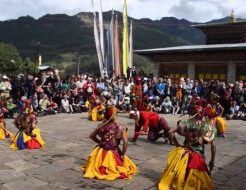
Bhutan Naked Festival 2024
The Jambay Lhakhang, situated in Bumthang and en route to the Kurjie Lhakhang, is the venue for…
Start Date: 15th November 2024
End Date: 18th November 2024
Destination: Jambay Lhakhang, Choekhor, Bumthang
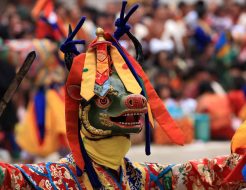
Bhutan Thimphu Festival Tour 2024
One of the biggest festivals in the country is the Thimphu Tshechu. This Thimphu festival tour is…
Start Date: 13th Sept 2024
End Date: 15th Sept 2024
Destination: Tashi Chhodzong, Thimphu
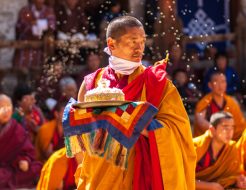
Punakha Festival Tshechu 2024
Punakha, situated in the western part of Bhutan, serves as the winter residence of the Je Khenpo,…
Start Date: 19th - February 2024
End Date: 21st February 2024
Destination: Punakha Dzong
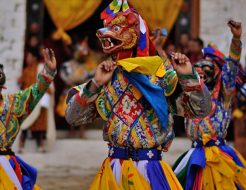
Paro Bhutan Festival 2024
The Paro Festival, an annual event held every spring, stands as one of the most vibrant and…
Start Date: 21st March, 2024
End Date: 25th March, 2024
Destination: Rinpung Dzong, Paro
CONTACT US
- homeThimphu, Bhutan
- emailbookbhutantour@gmail.com
- emailinfo@bhutantouragency.com
- +975-17614054
- +975-02-340662
- +975-17614054
- rdtamang





